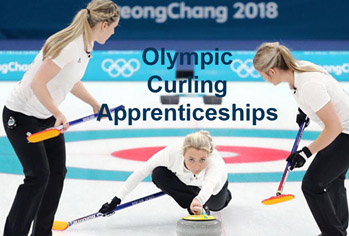Apprenticeships in Olympic Curling

While there isn’t an apprenticeship that trains you how to curl, we look at the range of apprenticeships you may not have thought of that support the sport.
This month Great Britain bought home gold and silver medals in curling. We take a look at some of the apprenticeships available across the Liverpool City Region that support the sport. While there are apprenticeships in administration, marketing and digital etc. that are important for running clubs and associations, there are some you may not imagine would be relevant.
Stone masonry is a skill required to make curling stones. The ones used for Olympic curling are made exclusively of granite from Ailsa Craig. Kays Curling, founded in 1851, has the exclusive rights to harvest granite from Ailsa Craig. Less obvious apprenticeships, may be found in the skill sets required to make the ice lanes on which the sport is played.
Olympic ice is important as it must deliver a consistent surface to ensure that the game is one of skill and strategy, rather than chance. The ice must allow the stone to travel the length of the lane in 25 seconds with more than 4 to 5 feet of curl. The surface temperature needs to be around 23 degrees Fahrenheit. Before athletes take to the ice, a rock mover rakes a line of curling stones across the lane to simulate play. This breaks the ice in for the players.
This year, in Beijing, the curling venue has been reimagined using facilities built for the 2008 Summer Olympics. Then known as the Water Cube, it became the Ice cube. British medals have been won in an Olympic swimming pool. Making Olympic curling lanes has been a unique challenge. It began with creating a platform for the 10cm thick ice lanes. Here’s opportunities for a Structural Steelwork erector or steel fixer apprentice. Scaffolding was used to raise the floor height of the swimming pool. A platform of concrete was then formed to support the ice. Construction plant operative apprentices become skilled at that.
When it comes to creating the ice for Olympic curling, the quality of the ice is important. The lanes are made up of numbers of flat layers, frozen from the bottom up to remove inconsistences. Normally, ice freezes from the top down, so this is a skilled operation. The quality of the water used is also important. The tap water didn’t make the grade, so water treatment systems were needed to remove the minerals from the water, a job for water process technicians with an understanding of ion exchange.
Once constructed the lanes need to be maintained throughout the competition. The ice technicians work to around 1,000th of an inch tolerances. The building, despite being a reimagined swimming pool, was too dry. A system of humidifiers releasing a constant mist around the periphery of the ice was installed. These are challenges that an environmental practitioner could assist with.
As the curling teams took to the ice to deliver hours of sporting excitement, the skills of many other specialists made sure the ice lanes matched the athletes’ skills. Perhaps your apprenticeship might take you to Cortina in 2026.
If you would like further information on apprenticeships and how to apply for them, talk to the Apprenticeship Support by Be More Team They provide impartial information and advice on apprenticeships across the Liverpool City Region.